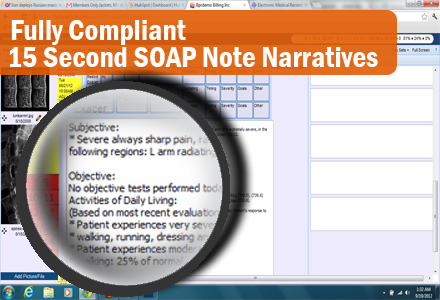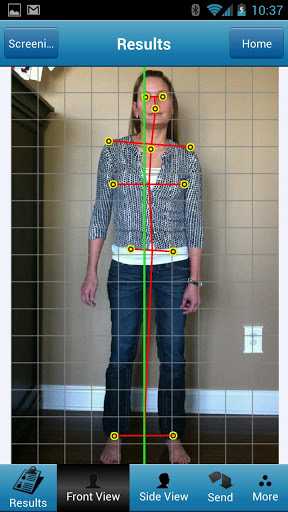Practice Growth Through Chiropractic Software

First Impressions Does Dr. Ben really know how to run his practice growth? Ben sat on the bench in the museum’s Impressionists room, staring at a giant canvas. His wife and son were strolling around the room, talking about details in the other paintings, and he knew that Carmen was having to focus so much on Jonathan that she probably wasn’t getting the full experience of being in an art museum. But somehow he was having trouble getting out of his own thoughts enough to enjoy time with his family. Even surrounded by amazing works of art, he was thinking about work. “Thinking about work?” Carmen asked, coming to a stop beside him. Jonathan climbed up on his lap. Ben had to laugh — it was uncanny how Carmen could read his thoughts sometimes. Although it seemed as though he was always thinking about work lately. “I guess,” he admitted. “I thought things were going well,” Carmen said, sitting beside him. “They were. They are,” said Ben. “I just feel like every time I get my problems solved, they regroup and come back at me.” Carmen gazed at the flowers on the wall. “Can I be perfectly honest?” “Of course!” Ben was surprised. “Aren’t you always perfectly honest with me?” “I try to strike the balance between honest and supportive.” Carmen darted a look at Ben. Jonathan, worn out from walking, was half asleep. “I think you don’t know as much about running your practice as you need to. Maybe not as much as think you do, even.” Ben frowned. “That’s honest, okay. Maybe not supportive.” “I’m not saying anything about how you treat your patients. I’m just saying it’s not really scalable.” Ben looked inquiringly at his wife. “Managing a small practice where you see a few patients a day is not the same as managing a growing practice. You want growth, of course, and you’re a great chiropractor, so you get more patients — and you have a crisis while you figure out how to serve them all. Then you add a partner or another staff member, and you have a crisis while you figure out how to pay for them and how to manage them. Then you get more patients so there’s enough money to go around, but then you have another crisis figuring out how to keep track of everything. Your practice grows, but you sort of go from crisis to crisis.” Ben looked back at the peaceful flowers in the painting. From crisis to crisis was a pretty fair description of how he felt. “We want growth,” he said. “We need it, even. We have to think about Jonathan’s future — lessons, sports, even college tuition. And we have to think about our retirement, and let’s face it, we want and deserve a certain kind of lifestyle. I don’t think that going back to the way things were my first year in practice is the solution. You’re right, though — I felt a lot more competent back in those days.” “What about the technology solutions we’ve talked about. Have you invested in them, yet?” “We’ve done a few things,” Ben said slowly. Now that he thought of it, though, a lot of the new tools they’d talked about were still being talked about. “I know I couldn’t have handled the growth of the pizzeria if I was trying to make all my pizzas with a bowl and a wooden spoon,” Carmen said. “You need good tools.” She stood and stretched. Ben picked up his sleepy son and put an arm around his wife. “I think I’ve had enough of the Impressionists,” he said. “But what you said definitely has made an impression on me.” “Good,” Carmen smiled. Does Dr. Ben really know how to run his growing practice? Disclaimer: For HIPAA compliance, all characters appearing in this post are fictitious. Any resemblance to actual persons or actual events is purely coincidental.
Start Building Chiropractic SOAP Notes With XMR Technology

By Erez Lirov — CTO XMR stands for eXtensible Medical Records technology which was created as part of the Vericle platform to help chiropractors save time on patient visit documentation. Basically, XMR technology lets a chiropractor document a patient’s visit quickly and easily in a few simple steps while he is still with his patient. The idea is to have the ability to very quickly look at a set of existing patient notes, absorb the information from the previous visit and quickly make a new note for the current visit by modifying information about the past visit, without actually modifying the previous record. Watch the video below for more info: The most important concept of XMR techn0logy is the ability to create a new note based on the old note. So let’s look at XMR , why it works and why it’s so effective. The most important part of XMR is the complete absorption of the medical record to understand everything about the previous visit. It turns out that there’s really two ways to do this. One way would be to look at a narrative. For example, patient presents with pain in their left shoulder, throbbing pain– in other words you can imagine that there could be a whole paragraph describing the complaint of the patient and the subjective findings. To read a note like this and comprehend it quickly can be a very draining activity on a mental level because reading is a conscious activity. It takes a lot of our conscious effort since we have to focus on it in order to retain what we are reading. The other way to look at this type of information is to block it out and look at the actual values of the note itself. In other words, we know that the patient has some sort of pain, we know that it’s in their left shoulder and we know that it is a level eight. By having the patient information in blocks like this, I can very quickly tell that this patient has left shoulder pain on a level eight. I don’t have to parse through the rest of the sentence and I don’t have to understand exactly what’s going on with the order of the words. This turns the activity from a very mentally intensive, a very conscious level activity to a very automatic activity where I can just look at this the same way I look at street signs and react to the info very quickly.The idea behind this is that it is something that takes minutes and a lot of active mental activity, and turns it into something takes seconds with very little conscious mental effort. What does that do? It means that I can do all of my notes much more quickly, and more importantly I can really use the rest of my brain power to really focus upon the patient themselves and what it is I’m trying to achieve with the patient and how I want to take care of them,and my plan going forward. So half of the advantage of XMR technology is the ability to comprehend the previous note as quickly as possible by looking at the signs of the note which are essentially the labels, instead of reading through an entire paragraph of narrative from the previous note. The second part of XMR is the capability to create the next note by pulling data from the previous note instead of starting from scratch. It allows you to simply click into a value like the pain level, for example, and change it to a seven, or any other value. What that means is that rather than thinking about creating a new note from scratch, I’m thinking about just making small changes in the current note and the system automatically copies all of the information for me and creates a whole new note and a whole new narrative out of that original note. Then for the next visit I won’t need to parse the narrative, but I can just simply absorb the ‘street signs’ and understand what’s going on with the patient in a glance.
Improve PVA With Integrated Posture Assessments

If you are looking for a way to improve the Patient Visit Average (PVA) and increase profitability as part of your “new patient” marketing efforts, you should consider using the posture assessment tools that are already integrated into your Genesis chiropractic EHR system. You will be able to impress prospective patients at health fairs and other marketing events with a visually effective, instant diagnosis via the PostureScreen App on your iPad, iPhone, or Android. Even more importantly, you will be able to collect and save their contact info in your Genesis patient data base at the same time. Since PVA is computed by dividing the number of total office visits by number of new patients in a chosen time frame, you can improve this value by increasing the conversion percentage of intro visits to care plans. The old adage that the eye buys holds true for the use of posture assessments because this visual tool lets a potential patient see any spinal misalignments for him- or herself and, therefore, ‘buy’ the diagnosis and need for chiropractic treatment. This type of patient education can increase the number of new patients resulting from marketing events while also improving first-visit conversions. The end result will be a higher ROI on your marketing efforts. The EHR integration ties everything neatly together by providing the opportunity to create a new patient file in your Genesis system within minutes or quickly update an old one while still with the patient. Any personalized results of the posture assessment can then be emailed to the patient for an opportunity to schedule a follow-up appointment or reinforce the patient’s compliance with a prescribed exercise program.
Is PVA BS for chiropractic?

A notable number of first time chiropractic patients never return for scheduled subsequent visits. This frequently occurs due to headaches, fatigue or even soreness perceived to be related to the initial visit. For this reason many chiropractors do not consider the initial visit the patient’s true first visit. PVA (total patient visits divided by total new patients for a given period of time) allows a practice to measure successful patient relationship management. It only makes sense to include patient education as an important ingredient for improving this metric. Having a system in place to directly improve this trend can have a notable impact on a clinic’s overall profitability. In today’s information age, more and more patients are taking an active role in their wellness education in hopes of better understanding their condition and the source of their discomfort or pain. Because of this many successful online resources catering to patient education across all medical specialties have come into existence such as WebMD, PostureCo and, on a more sinister note, misleading publications sourced from opposing medical specialties. Many patients have already googled their symptoms and researched any possible causes as well as solutions long before they actually set foot into your practice. Chiropractic, in general, faces more than its fair share of misguided opposition, generally sourced from “big pharma” and even the AMA. Because of this your clinic needs to be armed with compelling, easy-to-understand patient education of its own. Nurturing this natural curiosity in a positive way via patient education can therefore, improve the chiropractor patient relationship, first visit conversions and the overall Patient Visit Average (PVA). Not only can a high PVA lead to exponential growth for the practice, but it will also improve profitability since it is notoriously cheaper to keep a patient than to attract a new one. Patient education can be broken down into 3 major categories: Introduction to chiropractic, the clinic and the background of the doctor on practice website: New patients should generally gain an understanding of chiropractic as a whole and how it differs from medical treatment before they come to their first appointment. Featuring this information in a friendly and easy to digest way on your chiropractic website should help establish a basic understanding among new patients and reduce any misperceptions. It is also important to increase the level of comfort for new patients by showing them what the practice looks like, who works there and what the doctor’s area of expertise is in a brief intro video. Patient conditions & treatment via Posture Screen: When patients are shown educational graphics and videos about the cause of their pain and discomfort during their appointment they are much more likely to return for more treatments. Furthermore, patients will feel more motivated to follow a prescribed exercise plan via videos and clearly written instructions. As a result, these educational materials should also be emailed to patients via xDocs immediately after the appointment to reinforce patient compliance. Ultimately, these patient relationship management tools will also enhance a chiropractor’s credibility and built trust with his patients. Chiropractic lifestyle via blog, videos, newsletters, social media: Since chiropractors generally promote healthy lifestyles and injury prevention they can provide valuable information to specific patient personas in daily or weekly blogs, videos, newsletters, and social media posts. It is imperative to avoid sales pitches though and focus completely on educating patients. This may also lead to referrals when existing patients share this useful content with their family and friends. Ultimately, patient education must be delivered across all 3 major categories to realize its full potential. This approach to PVA has been and will continue to be a game changer for those that embrace this patient education model in its entirety.

